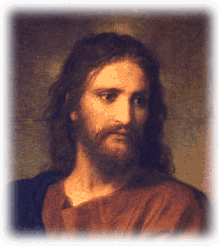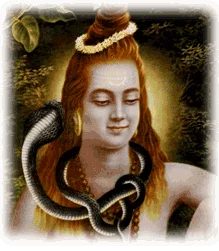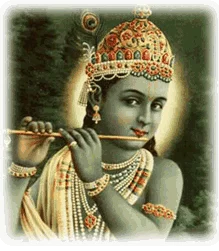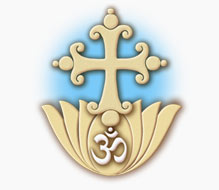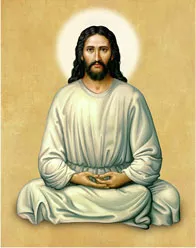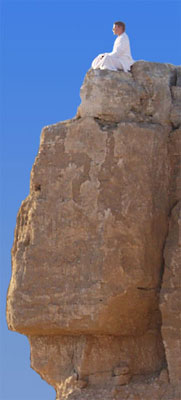
“Yoga” is a Sanskrit word that means “to join.” Yoga is both union and the way to that union. What do we join through yoga? First, we join our awareness to our own essential being: the spirit whose nature is pure consciousness. In yoga philosophy this is known as the Atman or Self. Next, we join our finite consciousness to the Infinite Consciousness, God, the Supreme Self (Paramatman). In essence they are eternally one.
According to yogic philosophy the individual atman-spirit originally dwelt in the consciousness of that oneness. But in its descent into the material world the spirit lost its awareness of the eternal union, and lost the capacity to live in and manifest the union on a practical level. Through yoga the lost consciousness can be regained and actualized in the individual’s practical life sphere.
Regarding this, a yogi-adept of the twentieth century, Dr. I. K. Taimni, remarks in his book The Science of Yoga: “According to the yogic philosophy it is possible to rise completely above the illusions and miseries of life and to gain infinite knowledge, bliss, and power through enlightenment here and now while we are still living in the physical body.…No vague promise of an uncertain postmortem happiness this, but a definite scientific assertion of a fact verified by the experience of innumerable yogis, saints, and sages who have trodden the path of yoga throughout the ages.”
Since rational thought precedes rational action, we should begin with the philosophical side of Yoga.
Yoga philosophy
The basic text of the Yoga philosophy is the Yoga Sutras (also called Yoga Darshana), written by the sage Patanjali, a yogi of ancient India. In contrast to other philosophical systems, Yoga is a philosophy which stimulates its investigators to engage in yoga as a practice through which they will experience and demonstrate its truth and worth. What begins as theory develops into practice which culminates in realization. Yoga is philosophy, discipline, and experience. It is a revelation of consciousness.
In the Bhagavad Gita, Krishna the teacher tells Arjuna the student: “There was never a time when I did not exist, nor you, nor any of these kings. Nor is there any future in which we shall cease to be” (Bhagavad Gita 2:12). We are eternal beings, without beginning and without end.
Originally we were points of conscious light in the infinite ocean of Conscious Light that is God. We were gods within God. And so we still are, for it is not possible to be outside of Infinity. Yet we are also here in this ever-changing world–a place that completely overwhelms the truth of our immortal life within God. For countless life-cycles we have found ourselves embodied in material cases, little body-prisons within the greater prison of the cosmos. And that is where we are right now.
God the Lord–Ishwara
In writings on Yoga, the word for God or Lord is Ishwara–the Ruler, Master, or Controller possessing the powers of omnipotence, omnipresence, and omniscience. Ishwara is the Supreme Power, Parameshwara. It is toward this Ishwara that our life is to be directed if we would attain perfection in yoga. In Yoga Sutra 1:23, Patanjali says that samadhi, the state of superconsciousness where Absoluteness is experienced, is produced by Ishwarapranidhana–the offering of one’s life to God. This is not merely dedicating our deeds and thoughts to God, but consciously merging our life in the greater life of God and making them one.
Since yoga is a practical matter, we need some workable, pragmatic understanding of the nature of God. For how will we seek and recognize Him if we have no idea who He is? Patanjali supplies us with exactly the kind of definition we need: “Ishwara is a particular Spirit Who is untouched by the afflictions of life, actions [karma] and the results and impressions [conditionings] produced by these actions” (Yoga Sutras 1:24).
God is a special, unique, conscious Being–not just abstract Existence. God is a “particular Spirit” in the sense that God can be “picked out” or “singled out” from among all other things or beings.
Though God is within all things and all things are within Him, yet He stands apart. This is stated several times in the Bhagavad Gita: “They are contained in me, but I am not in them…I stand apart from them all, supreme and deathless” (7:12, 13). “For my spirit stands apart, watching over Maya, the maker” (9:9). “Standing apart, He sustains” (13:14). “He is within and without: He lives in the live and the lifeless: subtle beyond mind’s grasp; so near us, so utterly distant” (13:15). “Although I am not within any creature, all creatures exist within me” (9:4).
God is unique in the sense that He is Ekam Evam Advityam Brahman–the God Who is One, Only, Without a Second. He is not one of many, nor is He even one of two. He is ONE in every sense of the term. God is neither conditioned nor confined in any manner. Therefore He is not touched or tainted by the afflictions or faults of life (relative existence), in contrast to us who live within them as though they were the air we breathe and the basis of our existence. Nor is Ishwara bound or in any way conditioned by actions; therefore He is ever unchanging.
It should be noted that Ishwara is considered to be Male in contradistinction to the divine creative power–Prakriti or Shakti–that is Female. Consequently Ishwara is referred to as “Him.” Brahman the Absolute is referred to as “It” because Brahman transcends such dualities as male and female, positive and negative. (Since the English word “God” almost always implies Ishwara, in this book God will be referred to as “He.”)
Infinite Consciousness: Omniscience
God is the essence and the apex of Consciousness, so Patanjali further says: “In Him is the highest limit of omniscience” (Yoga Sutras 1:25). Commenting on this, Shankara says: “The all-pervading mind of the supreme Lord is in simultaneous contact with every object.” The omniscience of God is total and absolute, for in truth God is Omnipotence, Omniscience, and Omnipresence.
In this sutra Patanjali introduces a significant fact. He does not just say that omniscience (sarvajña) is in God, but that the seed of omniscience (sarvajña bijam) is in Him. Within God is the seed or potentiality of omniscience for those who are united with Him through their practice of yoga. Omniscience is not just objective knowledge, but infinity of consciousness–the Being of God Himself.
The two Selves
“Who am I?” is the age-old question asked with “Who is God?” The true “I” of each sentient being is the individual spirit, the self (atman). But there is more. God (Brahman) is the Self of the self–as the ocean is the “self” of every wave. The illumined know that they are the immortal self whose ultimate Self is the Immortal Itself. We are spirits within Spirit, in a wondrous way both ourselves and Brahman, both finite and infinite.
“Like two birds of golden plumage, inseparable companions, the individual self and the immortal Self are perched on the branches of the selfsame tree. The former tastes of the sweet and bitter fruits of the tree; the latter, tasting of neither, calmly observes. The individual self, deluded by forgetfulness of his identity with the divine Self, bewildered by his ego, grieves and is sad. But when he recognizes the worshipful Lord as his own true Self, and beholds his glory, he grieves no more” (Mundaka Upanishad 3.1.1, 2)
“That being who is the power of all powers, and is born as such, who embodies himself in the elements and in them exists, and who has entered the lotus of the heart, is the immortal self” (Katha Upanishad 2:1:7).
“In the effulgent lotus of the heart dwells Brahman, who is passionless and indivisible. He is pure, he is the light of lights. Him the knowers of the self attain” (Mundaka Upanishad 2.2.9).
“Brahman is supreme; he is self-luminous, he is beyond all thought. Subtler than the subtlest is he, farther than the farthest, nearer than the nearest. He resides in the lotus of the heart of every being” (Mundaka Upanishad 3.1.7).
“He who glows in the depths of your eyes–that is Brahman; that is the Self of yourself. He is the Beautiful One, he is the Luminous One. In all the worlds, forever and ever, he shines!” (Chandogya Upanishad 4:15:1).
Meditation is the key to knowledge of the self and the Self of the self. Knowing one, both are known–so say the sages. “Wise, self-controlled, and tranquil souls, who are contented in spirit, and who practice austerity and meditation in solitude and silence, are freed from all impurity, and attain by the path of liberation to the Immortal, the truly existing, the changeless Self” (Mundaka Upanishad 1.2.11).
Dr. I. K. Taimni, in The Ultimate Reality and Realization, says this:
“It is only when the realization of being a pure spirit or atma has been attained that it is possible to achieve the final goal of union of the atma with the Paramatma, the Supreme Spirit which exists eternally beyond the manifested universe and from which the manifested universe is derived. When this final realization has been attained and union of atma with Paramatma has been brought about there is not only a complete sharing of consciousness between the two but also of the infinite Power which is inherent in the Universal Consciousness.…It is necessary to distinguish between the powers which are acquired on the realization that he is a pure spirit or atma and those which are attained when he is able to destroy the last vestige of egoism and his consciousness becomes united with that of Paramatma. The former, though tremendous in some respects, are still limited, while the latter which are really the Powers of the Supreme Spirit are infinite and can manifest through the center of consciousness of a self-realized individual because there is fusion of the individual consciousness with the Supreme Consciousness and the channel between the two is open.”
God and gods
We are gods within God, finite spirits within the Infinite Spirit. But what is spirit? Yoga tells us that spirit is consciousness. We are eternal consciousnesses, each of us individual and distinct. Yet we are more. Each of us takes our being from God as the wave takes its existence from the ocean.
God is the eternal Root, the Ground, of our being, our greater Self. We are not God, but in some ineffable manner God is us–the Self of our self, the Spirit of our spirit. God is all, and we are the parts–each of us possessing an eternal and irrevocable distinction. That is why Krishna told Arjuna: “There was never a time when I did not exist, nor you, nor any of these kings. Nor is there any future in which we shall cease to be.”
“Both the individual self and the Universal Self have entered the cave of the heart, the abode of the Most High, but the knowers of Brahman see a difference between them as between sunshine and shadow” (Katha Upanishad 1:3:1).
God and creation
God, the infinite Spirit, is pure consciousness, but has extended or emanated Himself as the cosmos: physical, astral, and causal. “This universe, before it was created, existed as Brahman. ‘I am Brahman;’ thus did Brahman know himself. Knowing himself, he became the Self of all beings” (Brihadaranyaka Upanishad 1:4:10). This seemingly dual nature of God as Light and Power, as Consciousness and Matter, has puzzled the minds of even the wise.
God, the Original Being, projects Himself as the ever-changing dance of creation, as the evolving light that is the cosmos. God projects the creation, evolves it, and withdraws it back into Himself in a perpetual cycle. The creation can be thought of as God’s body–that God becomes incarnate in creation again and again. And as parts or reflections of God we do exactly the same through reincarnation.
There is a law that governs the place and kind of our embodiment. That law is karma, the principle of exact and inevitable reaction to our own actions and mental states, resulting in a seemingly endless domino effect of continual birth and death. Yoga offers us the possibility of ending this chain of embodiments by awakening-transformation from time and mortality into eternity and immortality.
And us…
All conscious beings have existed eternally within the Being of God, one with Him, distinct though not separate from Him. Rooted in the infinity of God, they have within themselves an innate impulse to transcend their finitude and attain the boundlessness of their Origin. This is impossible, since they are as immutable as God–the only infinite Being. They can become godlike, but they cannot become God. Yet the urge for transcendence is part of their nature.
The solution to this dilemma is simple. The individual consciousnesses cannot alter their natural state of finitude, but they can come to share and participate in the infinite Consciousness of God. Even though they cannot become infinite themselves, they can experience the infinity of their divine Source, just as a psychically sensitive person can experience the thoughts and feelings of others without becoming them. In the same way, spirits can evolve to experience the Consciousness of God while remaining in their naturally limited state. They do not become God the Absolute, but they enter into that Absolute Life and are one with it.
As Shankara explains in his Yoga Sutra commentary: “When the light of several lamps appears simultaneously, it cannot be made out which is the light of which.” Consequently liberated spirits experience the infinite Being of God–infinite Consciousness–as their own being. Krishna has described it this way: “When you have reached enlightenment, ignorance will delude you no longer. In the light of that knowledge you will see the entire creation within your own atman and in me” (Bhagavad Gita 4:35).
When the spirits are unshakably established in that Consciousness the goal has been attained. All they need do is develop the capacity for such a state of awareness. This is done by learning to fully experience the state of existence of a being completely different from themselves–while retaining the awareness of their true identity. They can put on the “costume” of a consciousness utterly different from theirs, and not just experience that other mode of consciousness, but become able to function as that other kind of being.
Evolutionary creation
To enable the spirits to enter into this process, God breathes forth His own Self as the Power from which is manifested all the realms of relative existence, from the most subtle worlds of nearly-perfected beings to the most objective worlds of atomic matter. They can then enter into relative existence by taking on coverings, or “bodies,” of varying grades and patterns of vibratory energies. They descend into this material world and begin working their way up the ladder of ever-evolving forms. Beginning with forms whose scope of consciousness is vastly less than theirs, they work their way upward, entering into higher and higher levels of awareness until they can surpass their original breadth of consciousness and begin to partake of a life of awareness much beyond their own. This then culminates in their developing the ability to share in the Divine Consciousness Itself.
In the intervals between embodiments the spirit spends time in the astral regions where awakening and growth also take place. (This is best explained in the forty-third chapter of Autobiography of a Yogi by Paramhansa Yogananda.) Upward and upward they evolve until their capacity for awareness is developed to such a perfect state that they can experience and participate in God’s all-embracing Consciousness, thenceforth to live in His infinity.
As Shakespeare wrote, “all the world’s a stage” with the individual spirits wearing their costumes and playing their parts. Just as actors begin with small parts and progress to bigger roles by demonstrating their skill in those smaller parts, so also do the spirits advance to higher and more complex forms of existence and consciousness, at last returning home to God. The Sufi poet, Rumi, wrote:
A stone I died and rose again a plant.
A plant I died and rose an animal;
I died an animal and was born a man.
Why should I fear? What have I lost by death?
As man, death sweeps me from this world of men
That I may wear an angel’s wings in heaven;
Yet e’en as angel may I not abide,
For nought abideth save the face of God.
Thus o’er the angels’ world I wing my way
Onwards and upwards, unto boundless lights;
Then let me be as nought, for in my heart
Rings as a harp-song that we must return to Him.
Oliver Wendell Holmes, one of many great Americans whose belief in reincarnation is overlooked, wrote in his poem, The Chambered Nautilus:
Build thee more stately mansions, O my soul!
As the swift seasons roll!
Leave thy low-vaulted past!
Let each new temple, nobler than the last,
Shut thee from heaven with a dome more vast,
Till thou at length art free,
Leaving thine outgrown shell by life’s unresting sea!
That is the purpose of creation and our place in it.
God is the guru of all
Gorakhnath, the greatest of all yogis, asked his teacher, Matsyendranath, the first yogi in this creation cycle: “Who is the Primal Guru [Adiguru]?” And Matsyendranath answered: “The Eternal Beginningless One [Anadi] is the Primal Guru” (Gorakh Bodha 21, 22). He continued: “Realization of that Guru gives us immortality” (Gorakh Bodha 24).
Since God is eternal, it is from Him that all knowledge has come–especially the revelation of spiritual truth. As Vyasa observes: “His purpose is to give grace to living beings, by teaching knowledge and dharma [righteousness].” “There is no other but God to give the teaching which is a boat by which they can cross over the sea of samsara, and He teaches knowledge and dharma to those who take sole refuge in Him.…For all the kinds of knowledge arise from Him, as sparks of fire from a blaze or drops of water from the sea,” says Shankara. Therefore Patanjali concludes: “Being unconditioned by time He is Guru even of the Ancients” (Yoga Sutras 1:26).
Dwelling in the hearts of all, God continues to be the guru of questing souls. This does not mean that qualified spiritual teachers are not helpful to us, but ultimately the yogi must be guided by the Divine from within his own consciousness. So the God-illumined mind also becomes our guru. “The mind is itself guru and disciple: it smiles on itself, and is the cause of its own well-being or ruin,” wrote the great poet-saint Tukaram (Tukaram’s Teachings, by S. R. Sharma, p. 19). “The mind will eventually turn into your guru,” said Sri Sarada Devi, the consort of Sri Ramakrishna. (The Gospel of the Holy Mother, p. 340). Swami Brahmananda, the “spiritual son” of Sri Ramakrishna, in speaking about the role of an external guru said: “Know this! There is no greater guru than your own mind. When the mind has been purified by prayer and contemplation it will direct you from within. Even in your daily duties, this inner guru will guide you and will continue to help you until the goal is reached” (The Eternal Companion, p. 120).
Therefore Tukaram wrote in one of his hymns: “The guru-disciple relationship is a sign of immaturity” (Tukaram’s Teachings, p. 20). The fact that Shankara writes in the Nirvanastakam: “I am neither guru nor disciple [gururnaiwa shishya],” shows that in realization of the Self the limiting guru-disciple relationship is left behind and dissolves away. (There is, however, a non-limiting guru-disciple relationship, such as is seen in the relationship of Yogananda with Sri Yukteswar–especially after Yogananda’s return to India in 1935. This grows out of the earlier guru-disciple interaction if the guru is a perfectly liberated being and the disciple is positively moving toward liberation himself.)
Yogiraj Shyama Charan Lahiri Mahashaya wrote to a student regarding the guru: “No one does anything; all is done by God. The individual [that seems to be the guru] is only an excuse; remain abidingly focused on that Divine Guru; in this is blessing.” And to another: “Guru is the one who is all; Guru is the one who is merciful. You are the Guru within yourself” (Garland of Letters (Patravali), Letters 12 and 45). In Purana Purusha by Dr. Ashoke Kumar Chatterjee it is recorded that Yogiraj made these two statements: “I am not a guru. I do not hold the distinction of ‘guru’ and ‘disciple.’” “The Self is the Guru…the immortal, imperishable Guru.”
When Paramhansa Yogananda, who first made Lahiri Mahashaya known in the West through his autobiography, was questioned “about his own role in the religious evolution of this planet,” the great yogi replied: “The one Ocean has become all its waves. You should look to the Ocean, not to the little waves protruding on its bosom” (Swami Kriyananda. The Path, p. 493). Another time he objected strongly to the suggestion that only his writings should be read in the public services of Self-Realization Fellowship, saying: “I came to make you God-conscious, not Yogananda-conscious.” At other times he said: “There is no such thing as ‘Yogananda-realization,’ only God-realization.” To someone who asked about a “disciple,” Yogananda replied firmly: “I never speak of people as my disciples. God is the Guru: They are His disciples” (The Path, p. 327). Peggy Dietz, one of the Master’s secretaries, has written in her booklet, Thank You Master, on page 21, that Yogananda said: “Please remember that although I am touched by your love, God is the real guru. Worship Him.”
If an aspirant neither has nor desires an external guru he can still succeed in spiritual life. That this is so is proven by the fact that the twentieth-century Masters Shirdi Sai Baba, Neem Karoli Baba, Paramhansa Nityananda, Aurobindo Ghosh, Swami Sivananda of Rishikesh, Swami Rama of Hardwar (Ram Kunj), Om Baba of Delhi, Swami Ramdas of Anandashram, and Ramana Maharshi attained enlightenment without the agency of an external guru. Ramana Maharshi particularly emphasized that God is the guru of all, saying: “Only the Supreme Self, which is ever shining in your heart as the reality, is the Sadguru [True Guru]” (The Power of the Presence, p. 116).
The supreme example of someone who attained enlightenment without a guru is Buddha, who is referred to in Buddhist texts as “Self-Awakened.” All spiritual life is self-initiated from within; we are both guru and disciple as Krishna and Arjuna symbolize in the Bhagavad Gita.
Paramhansa Nityananda said: “He [God] is the One guru, the guru Who is in all, the guru of the universe. No [human] person can be your guru, a person can only be secondary. The real guru is Guru of the Universe” (Chidakasha Gita 105). To emphasize this, Nityananda never gave initiation or became a “guru” in any manner or sense, though he was inspirer, guide, and advisor to many.
Neem Karoli Baba was wont to say, “I make devotees [of God], not disciples” (Divine Reality, by Ravi Prakash Pande, p. ii).
Swami Sivananda of Rishikesh used to say: “I abhor gurudom”–the debasing of the student-teacher interaction to a personality cult.
A leading spiritual figure of the Ramakrishna Mission, Swami Premeshananda, a disciple of Sri Sarada Devi, once wrote: “We have presently become inundated by this ‘guru doctrine.’ The purpose of the guru is to lead us to the realization of God; but God has been left behind, and the guru has become the latest fashion. So it is not safe to talk about a particular person. If one places a powerful personality before others, they will hold on to him instead of to God.”
Swami Yatiswarananda, Vice-president of the Ramakrishna Mission, wrote to one of his students: “We really are not gurus. We bring the message of the Guru of gurus. What all service you can get from me you will. But please turn to Him for light and guidance, for peace and blessedness. As you yourself are finding, human beings are not good enough. The Lord, the Guru of gurus, alone can give us the shelter, the illumination and the bliss we need.” That sums it up very well. The aspiring yogi can then feel safe and assured that God will be his guru, just as He has been for all the enlightened throughout the ages.
In conclusion let us look at the words of Sri Ramakrishna himself on the subject as found in the Majumdar translation of The Gospel of Sri Ramakrishna: “Satchidananda [Existence-Consciousness-Bliss] alone is the guru; He alone will teach” (1.2.8; also: 4.2.1, 5.1.2, 5.5.1). “If somebody addresses me as a guru I say, ‘Away you rascal!’ How can I be a guru? There is no other guru except Satchidananda. There is no other refuge but Him. He alone is the ferryman who takes one across the ocean of relative existence” (1.12.8). “A man cannot be a guru” (2.19.6). “He who says of himself that he is a guru is a person of poor understanding” (3.17.4). “The more you will advance, the more you will see that it is He who has become everything and it is He who is doing everything. He alone is the guru and He alone is the spiritual ideal of your choice. He alone is giving jnana, bhakti and everything” (4.26.2). “Do you pray to Satchidananda Guru every morning? Do you?” (4.9.2).
In the Nikhilananda translation, on October 22, 1885, when someone refers to someone as Sri Ramakrishna’s disciple, he says: “There is not a fellow under the sun who is my disciple. On the contrary, I am everybody’s disciple. All are the children of God. All are His servants. I too am a child of God. I too am His servant. ‘Uncle Moon’ is every child’s uncle!”
The great fourteenth-century yogini, Lalla Yogeshwari, sang about finding her inner guru, her Self:
With passionate longing did I, Lalla, go forth.
Seeking and searching did I pass the day and night.
Then, lo, saw I in mine own house a learned man [pandit],
And that was my lucky star and my lucky moment
when I laid hold of him. (Lalla Vakyani 3)
Another teacher
According to Vyasa there is another teacher: our yoga practice itself. He says: “It is yoga that is the teacher. How so? It has been said: ‘Yoga is to be known by yoga. Yoga goes forward from yoga alone. He who is not careless [neglectful] in his yoga for a long time, rejoices in the yoga.’”
Shankara, commenting on these words of Vyasa, discusses the reaction that the awakening person has upon learning about the possibility of liberation from his present state of bondage: “Meditation on his own being, which is the cause that should lead to liberation, begins of itself, caused by karma of a previous life or else by steadfastness in renunciation in this present one. And it goes on of itself, without instruction from a teacher.”
The experience gained from yoga practice itself teaches us the reality and value of yoga. But even more, it opens our intuition and enables us to comprehend the inner workings of the subtle levels of our being and its mastery. Yoga truly becomes our teacher, revealing to us that which is far beyond the wisdom of books and verbal instructions. Moreover, it is practice of yoga that enables us to understand the basis and rationale of its methods and their application. The why and wherefore of yoga become known to us by direct insight.
In his commentary on Yoga Sutra 2:28 Vyasa says: “From practicing yoga, illusion [ignorance] is destroyed and perishes. When it is destroyed, there is manifestation of right vision. In proportion to the practice done, illusion is dispelled. In proportion to its destruction, the light of [spiritual] knowledge increases correspondingly. This increase is an experience of increasing refinement up to the realization of the true nature of the purusha [spirit].”
The Yoga Vashishtha says it clearly and truly: “God Consciousness is not achieved by means of the scriptures, nor is it achieved by the grace of your Master. God Consciousness is only achieved by your own subtle awareness.”
When Gorakhnath asked: “Who is the Guru that leads to the Goal?” Matsyendranath told him: “Nirvana itself is the Guru that leads to the Goal.” That is, the liberated condition of the Self, though presently buried beneath the debris of lifetimes of ignorance, is itself the inspirer and guide to the revelation of our eternal liberation.
The religion of Yoga
It is commonly said that Yoga is not a religion. But since religion is derived from the Latin word religere, which means “to bind back,” and yoga means “joining,” practically speaking yoga is the only religion. The many systems of dogmas and doctrines are by their very nature not really religions at all, and in most instances are systems of superstition–either by the nature of their ideas or practices or by the attitudes of their adherents toward their beliefs and disciplines. Only when Yoga and Self-realization are the matrix around which a philosophy has been formulated for their furtherance is it worthy of our consideration. Other philosophies only produce confusion and distraction from the Goal.
It is yoga alone which reunites the consciousness of the individual to its infinite Source, restoring the lost unity. Earlier I quoted a paragraph from I. K. Taimni’s book The Science of Yoga about the purpose of yoga, but omitting his preceding words regarding the relation of yoga to religion–or rather, their difference. Here they are now, for I think you will find them relevant:
“The Orthodox religious ideal which requires people to be good and moral so that they may have a happy life here and hereafter is really a concession to human weakness and the desire to prefer the so-called happiness in life to enlightenment.
“In this respect the philosophy of yoga differs fundamentally from most of the orthodox religions of the world which offer nothing better than an uncertain and nebulous happiness in the life after death. They say in effect ‘Lead a good life to ensure happiness after death, put your faith in God and hope for the best.’ According to yogic philosophy death no more solves your spiritual problem than night solves your economic problem. If you are poor you do not expect on going to bed that your economic problem will be automatically solved next day. You will have to get up the next day and begin where you left off the previous night. If you are poor economically you do not expect to get rich overnight and if you are poor spiritually, bound by illusions and limitations of all kinds, you cannot expect to become enlightened [by simply being reborn] or, if you do not believe in reincarnation, in the vague and unending life which is supposed to follow death.”
Yoga is the way we answer for ourselves the prayer:
Lead me from the unreal to the Real.
Lead me from darkness to the Light.
Lead me from death to Immortality.
Read the next chapter of How to Be a Yogi: The Implications of All This

